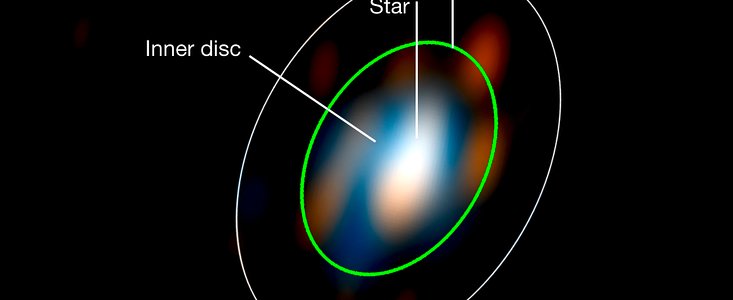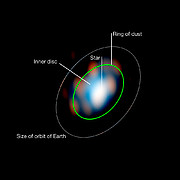Announcement
ESO’s VLT Takes First Detailed Image of Disc around Young Star
9 September 2010
New research carried out using ESO telescopes has, for the first time, allowed astronomers to reconstruct a detailed picture of the inner disc of matter around a young star. Stéphanie Renard of the Laboratoire d’Astrophysique de Grenoble and colleagues used the ESO VLT Interferometer to probe the secrets of the star HD 163296.
Young stars are surrounded by discs of dust and gas and scientists believe that it is in these discs that planets are born. Dusty grains in the disc stick to each other to make larger lumps that in turn also aggregate together. This growth is expected to continue until rocky bodies about the size of the Earth are formed.
“The power of the VLT Interferometer to probe very fine details now allows us to see the inner region very close to the star where there is not expected to be any dust. The new images reveal the ring-shaped structure of this very elusive region,” said Renard.
No single telescope currently in operation has vision acute enough to study such tiny and distant objects. The size of the region of the disc observed corresponds to 150 million kilometres — about the distance between the Earth and the Sun, but located at 360 light-years from Earth.
These very tiny details have an angular size of around 10 milliarcseconds — equivalent to trying to pick out small features on a road map held up 40 kilometres away. These minute angles are far smaller than any single telescope now operating can resolve.
To be able to image the inner part of the disc of matter close to the star, the team used a technique known as interferometry, in which sophisticated instrumentation combines the light from several telescopes into one observation. This increases the level of detail in the resulting pictures dramatically, although it does have some drawbacks: the results have to be reconstructed using complex mathematical algorithms because interferometry does not produce unambiguous images. But this difficult work is worthwhile as the resulting pictures tease out details far beyond the capabilities of the individual telescopes.
The team used data from the Very Large Telescope Interferometer, located at ESO’s Paranal Observatory, for the bulk of their work on this star. The facility includes four 8.2-metre Unit Telescopes and four 1.8-metre Auxiliary Telescopes, which can be used in several different combinations to produce interferometric observations. The data was thoroughly analysed earlier this year [1] but, now, for the first time, the astronomers have been able to reconstruct an image of such a young object, with minimal assumptions, thanks to a powerful mathematical algorithm developed by team member Eric Thiébaut. The resulting image has the detail you would normally expect from a telescope with a mirror over 130 metres across, far bigger than any currently in existence. To gain further precision, the team combined the VLT Interferometer observations with data from CHARA, Keck and IOTA interferometers.
“This is the first time that an image with such a level of detail has been achieved of a young star surrounded by a disc — a system that could represent how the Solar System formed 4.5 billion years ago,” said co-author Fabien Malbet. “We are eager to improve these images to understand the fundamental mechanisms that drive planetary formation better.”
“Creating an image of this star has really pushed back the boundaries of what is possible with current technology. It’s a showcase for what can be achieved when you combine the power of some of the most advanced observatories in the world,” concludes co-author Myriam Benisty. “Interferometry has definitely entered the world of images and the Very Large Telescope Interferometer is a crucial part of it.”
Notes
[1] This study was reported in "Strong near-infrared emission in the sub-AU disk of the Herbig Ae star HD 163296: evidence of refractory dust?" by M. Benisty et al. 2010, A&A 511, A74.
More Information
These results will be presented at the JENAM 2010 conference on 9 September 2010, in Lisbon, Portugal, in Symposium 6 "Science Cases for Optical and Infrared Interferometry", and will appear at the same time in the journal Astronomy and Astrophysics (“Milli-arcsecond images of the Herbig Ae star HD 163296”, by S. Renard et al.).
The team is composed of Stéphanie Renard and Fabien Malbet (Laboratoire d’Astrophysique de Grenoble), Myriam Benisty (INAF–Osservatorio Astrofisico di Arcetri), Eric Thiébaut (Centre de Recherche Astrophysique de Lyon) and Jean-Philippe Berger (European Southern Observatory).
ESO, the European Southern Observatory, is the foremost intergovernmental astronomy organisation in Europe and the world’s most productive astronomical observatory. It is supported by 14 countries: Austria, Belgium, Czechia, Denmark, France, Finland, Germany, Italy, the Netherlands, Portugal, Spain, Sweden, Switzerland and the United Kingdom. ESO carries out an ambitious programme focused on the design, construction and operation of powerful ground-based observing facilities enabling astronomers to make important scientific discoveries. ESO also plays a leading role in promoting and organising cooperation in astronomical research. ESO operates three unique world-class observing sites in Chile: La Silla, Paranal and Chajnantor. At Paranal, ESO operates the Very Large Telescope, the world’s most advanced visible-light astronomical observatory and VISTA, the world’s largest survey telescope. ESO is the European partner of a revolutionary astronomical telescope ALMA, the largest astronomical project in existence. ESO is currently planning a 42-metre European Extremely Large optical/near-infrared Telescope, the E-ELT, which will become “the world’s biggest eye on the sky”.
Links
Contacts
Fabien Malbet
Laboratoire d’Astrophysique de Grenoble, Université Joseph Fourier/CNRS
France
Phone: +33 476 63 58 33
Cell: +33 677 36 85 53
Email: Fabien.Malbet@obs.ujf-grenoble.fr
Richard Hook
ESO, La Silla, Paranal and E-ELT Press Officer
Garching bei München, Germany
Phone: +49 89 3200 6655
Email: rhook@eso.org
Our use of Cookies
We use cookies that are essential for accessing our websites and using our services. We also use cookies to analyse, measure and improve our websites’ performance, to enable content sharing via social media and to display media content hosted on third-party platforms.
ESO Cookies Policy
The European Organisation for Astronomical Research in the Southern Hemisphere (ESO) is the pre-eminent intergovernmental science and technology organisation in astronomy. It carries out an ambitious programme focused on the design, construction and operation of powerful ground-based observing facilities for astronomy.
This Cookies Policy is intended to provide clarity by outlining the cookies used on the ESO public websites, their functions, the options you have for controlling them, and the ways you can contact us for additional details.
What are cookies?
Cookies are small pieces of data stored on your device by websites you visit. They serve various purposes, such as remembering login credentials and preferences and enhance your browsing experience.
Categories of cookies we use
Essential cookies (always active): These cookies are strictly necessary for the proper functioning of our website. Without these cookies, the website cannot operate correctly, and certain services, such as logging in or accessing secure areas, may not be available; because they are essential for the website’s operation, they cannot be disabled.
Functional Cookies: These cookies enhance your browsing experience by enabling additional features and personalization, such as remembering your preferences and settings. While not strictly necessary for the website to function, they improve usability and convenience; these cookies are only placed if you provide your consent.
Analytics cookies: These cookies collect information about how visitors interact with our website, such as which pages are visited most often and how users navigate the site. This data helps us improve website performance, optimize content, and enhance the user experience; these cookies are only placed if you provide your consent. We use the following analytics cookies.
Matomo Cookies:
This website uses Matomo (formerly Piwik), an open source software which enables the statistical analysis of website visits. Matomo uses cookies (text files) which are saved on your computer and which allow us to analyze how you use our website. The website user information generated by the cookies will only be saved on the servers of our IT Department. We use this information to analyze www.eso.org visits and to prepare reports on website activities. These data will not be disclosed to third parties.
On behalf of ESO, Matomo will use this information for the purpose of evaluating your use of the website, compiling reports on website activity and providing other services relating to website activity and internet usage.
Matomo cookies settings:
Additional Third-party cookies on ESO websites: some of our pages display content from external providers, e.g. YouTube.
Such third-party services are outside of ESO control and may, at any time, change their terms of service, use of cookies, etc.
YouTube: Some videos on the ESO website are embedded from ESO’s official YouTube channel. We have enabled YouTube’s privacy-enhanced mode, meaning that no cookies are set unless the user actively clicks on the video to play it. Additionally, in this mode, YouTube does not store any personally identifiable cookie data for embedded video playbacks. For more details, please refer to YouTube’s embedding videos information page.
Cookies can also be classified based on the following elements.
Regarding the domain, there are:
- First-party cookies, set by the website you are currently visiting. They are stored by the same domain that you are browsing and are used to enhance your experience on that site;
- Third-party cookies, set by a domain other than the one you are currently visiting.
As for their duration, cookies can be:
- Browser-session cookies, which are deleted when the user closes the browser;
- Stored cookies, which stay on the user's device for a predetermined period of time.
How to manage cookies
Cookie settings: You can modify your cookie choices for the ESO webpages at any time by clicking on the link Cookie settings at the bottom of any page.
In your browser: If you wish to delete cookies or instruct your browser to delete or block cookies by default, please visit the help pages of your browser:
Please be aware that if you delete or decline cookies, certain functionalities of our website may be not be available and your browsing experience may be affected.
You can set most browsers to prevent any cookies being placed on your device, but you may then have to manually adjust some preferences every time you visit a site/page. And some services and functionalities may not work properly at all (e.g. profile logging-in, shop check out).
Updates to the ESO Cookies Policy
The ESO Cookies Policy may be subject to future updates, which will be made available on this page.
Additional information
For any queries related to cookies, please contact: pdprATesoDOTorg.
As ESO public webpages are managed by our Department of Communication, your questions will be dealt with the support of the said Department.


